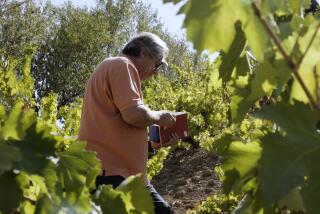Pink Rock Comes as Gift From Homeland in Answer to Armenian College’s Dreams
- Share via
It’s a drab, porous volcanic rock that looks like a hunk of pink concrete. But to Armenians, the pinkish stone, used in everything from ancient churches to department stores, is the closest thing to a national rock.
Three years ago, Garbis Der Yeghiayan, president of the American Armenian International College, asked Soviet Armenian officials for a few slabs of the stone, called touf, for the college’s new building in La Verne.
Flabbergasted by News
So Der Yeghiayan was flabbergasted when he was told in December that two boxcar-sized containers holding almost 50 tons of touf were waiting for him at Los Angeles Harbor. Since the stone arrived, he has been inundated with calls from all over Los Angeles, which has the largest Armenian community outside of Armenia, an estimated 200,000 strong.
The stone was donated to the college, the only Armenian college in the Western Hemisphere, by the Soviet Armenian government’s Committee for Cultural Relations With Armenians Abroad.
“There it was, 97,000 pounds,” Der Yeghiayan said. “It was unbelievable. I literally cried because this was the first time I saw Armenia in America.”
“Every day, people are calling asking for a piece,” Der Yeghiayan said. “I should say they are not just wanting a piece, they are very kindly demanding it. Some are literally begging me.”
He said he has been offered a substantial sum for 25 tons of the stone. He declined to say how much, but said it was enough to pay for a hefty chunk of the new $4-million college building. Der Yeghiayan politely refused the offer.
Many Armenians have never seen the stone, because they grew up in countries such as Syria and Lebanon, where their families fled after the widespread killing and deportation of Armenians by the Turkish government during World War I.
Powerful Cultural Allure
But even for those Armenians, it exerts a powerful cultural allure as a link to a homeland they only know through pictures and stories. Touf is found throughout the rocky landscape of Armenia and decorates the country’s most treasured buildings.
“It has lived through our history for 3,000 years. It has seen many battles and many wars, many victories and defeats,” Der Yeghiayan said. “You touch it, and it is like touching 3,000 years of history.”
The English word for touf is tuff, but many still call it by an obsolete name, tufa, which geologists now use to refer to a different sedimentary rock. The stone is formed out of the falling ash and debris from volcanoes, and can be found throughout the world, including Bishop, Calif., the Shasta Valley, and Managua, Nicaragua, said George R. Rossman, professor of mineralogy at Caltech.
To Armenians, though, the stone is unique. They often refer to Yerevan, the capital of their homeland, as “Vartakouyn Kaghak,” or the “Pink City” because of the extensive use of the stone, which can vary from pink to a light purple.
“We do not have oil, we do not have agricultural areas, we have only one lake and even that is in trouble,” said the Rev. Arshag Khatchadourian, pastor at St. James Armenian Apostolic Church in Los Angeles. “The only thing the country has is stone.”
Der Yeghiayan’s quest for the touf began when he made a trip to the Armenian Soviet Socialists Republic in 1985 with La Verne Mayor Jon Blickenstaff. The trip was sponsored by the Committee for Cultural Relations.
It was Blickenstaff’s first trip to Armenia, and he was stunned by the pink colors of Yerevan.
“The first time I noticed, it was clear day and I looked out my hotel window at the buildings and Mt. Ararat behind them,” he said. “The sun was shining on the buildings and it was a beautiful sight.”
Blickenstaff and Der Yeghiayan decided to ask Armenian officials if they could get some of the stone for the college. “They just sort of smiled and nodded,” he said.
Although the officials seemed to show little enthusiasm, Der Yeghiayan persisted after he returned to the United States. “Even taking a small piece out of the country is difficult because it is considered a national treasure,” he said.
But at 2 a.m. one September morning, three years after he had first proposed the idea, Der Yeghiayan received a phone call from Armenia informing him that a shipment of touf was on its way to the United States from the port of Leningrad. The caller did not say how much was coming or when it would arrive.
“I thought I was dreaming because I have dreamed about this every night,” he said.
Three months later, the stone, in 5,000 slabs, arrived in Los Angeles. “Then I believed it was real,” he said.
“It’s a gift of the heart from one part of our people to another,” said Arra S. Avakian, a retired professor of Armenian studies at Cal State Fresno. “It would be like someone taking a chip off the Blarney Stone and bringing it to New York City.”
The college, which is affiliated with the University of La Verne, is scheduled to begin construction of its new building next month.
Der Yeghiayan said the new 34,000-square-foot facility, which will include classrooms, lounges, a museum and a library, will give the college room to grow and strengthen its identity as an Armenian college. The touf will be used on the building’s front facade and parts of the interior.
More to Read
Sign up for Essential California
The most important California stories and recommendations in your inbox every morning.
You may occasionally receive promotional content from the Los Angeles Times.














